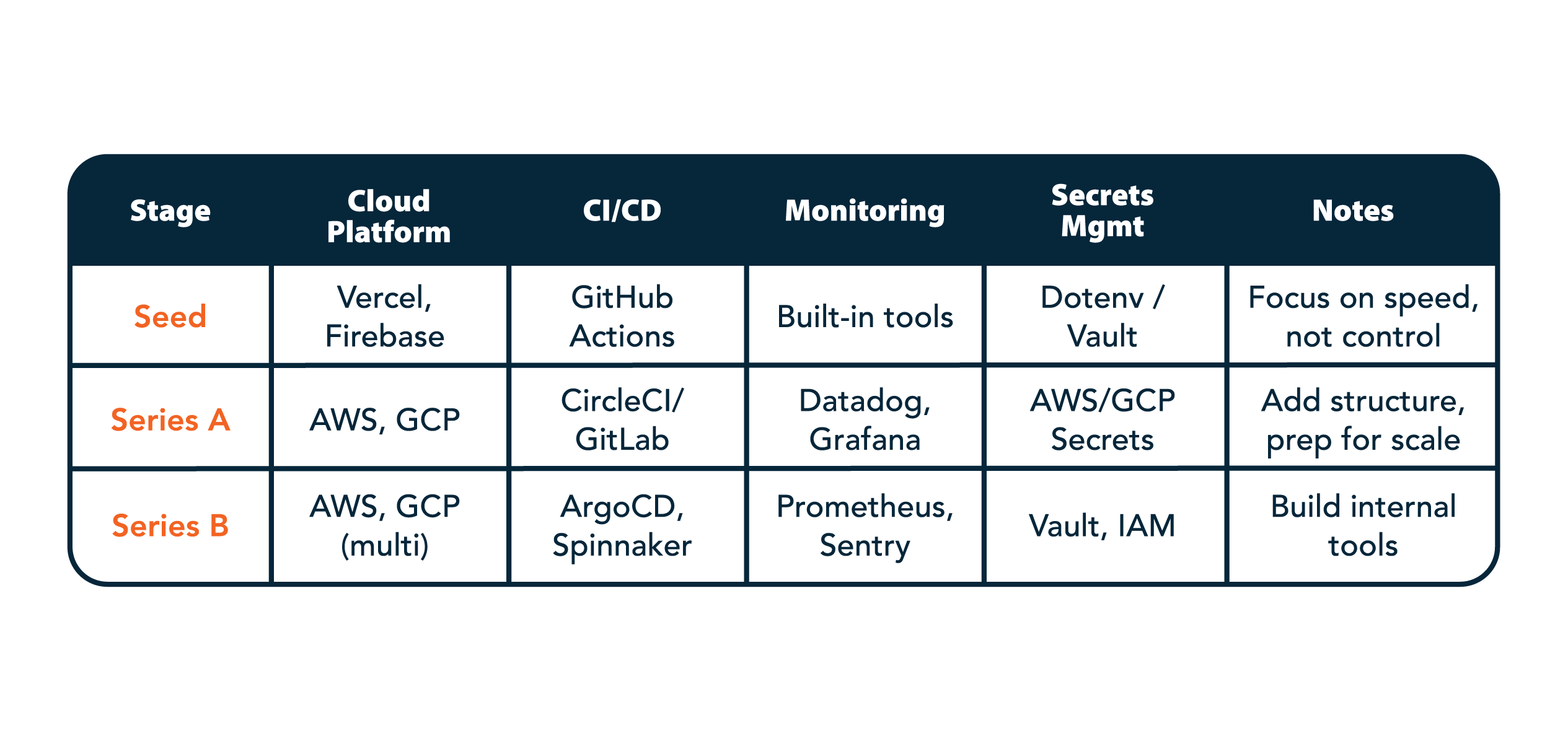
Essential CTO Startup Practices for Scaling with Security
Intro
Cloud infrastructure is the inevitable backbone of every SaaS startup and business. Founders and CTOs often make key cloud infrastructure decisions and manage budgets. This guide outlines practical, stage-appropriate infrastructure strategies for Seed, Series A, and Series B SaaS startups.
1. Foundational Concepts
These recommendations for the key startup stages, keep in mind the core principles of scalability, security, observability, and cost control.
- Scalability: Your stack should grow with your business without constant rework.
- Security: Security debt is harder to repay than technical debt.
- Observability: If you can’t measure it, you can’t manage it.
- Cost Control: Infrastructure isn't free; track and optimize as you grow.
2. Seed Stage (0–10 Employees, MVP Focus)
At the Seed stage, startups tend to move fast, key goals being reaching the next significant funding stage with minimal monthly spending while reaching the product-market fit.
Jerry Greenfield (of Ben & Jerry’s) famously said: “Startups are often very undercapitalised, but I found that to be very beneficial because it forces you not to throw money at problems. Instead, you learn all the nuts and bolts of what you're doing and become an expert.”
Because cloud infrastructure costs are the second line item in any tech startup budget, the earlier you start, the greater the impact is possible when practicing and perfecting cloud cost discipline. Here is what to pay attention to at the Seed stage:
Infrastructure Practices
Simple, standard options are your allies at the get-go.
- Use fully managed platforms like Heroku, Vercel, or Firebase for speed.
- Choose serverless (e.g., AWS Lambda) or low-ops services to reduce overhead.
- Start with one environment (prod) to reduce complexity.
Security Practices
Start thinking about security early on by enforcing a few key rules.
- Enforce multi-factor authentication (MFA) for all admin tools.
- Start using cloud-native secret managers (e.g., AWS Secrets Manager).
- Keep infrastructure simple to limit the attack surface.
Cost Management
As a startup founder, you can go a long way with cloud providers keen to see you grow.
- Stick to free tiers and startup credits.
- Monitor cloud costs weekly (and track unit economics).
- Use autoscaling and idle shutdowns for dev environments.
Scaling Considerations
Some tools are more scalable than others. Be wary of accepting advice to adopt the ones with a high adoptions barrier like Kubernetes.
- Use tools that can evolve: PostgreSQL instead of SQLite, Node.js/Django over no-code backends.
- Avoid early Kubernetes or custom infrastructure unless absolutely necessary.
3. Series A (10–50 Employees, Early Growth)
Series A is about doubling down on efficiency: for capital, unit economy, team, and tools. Establish discipline, improve reliability, and lay a foundation for scaling users and the team.
"Success is nothing more than a few simple disciplines, practiced every day," according to Jim Rohn. No matter what you think of motivational speakers, on this, he was not wrong.
Here are the steps to achieve discipline in the already-mentioned key areas:
Infrastructure Practices
Before scaling big, at Series A stage CTOs need to check whether they have a solid foundation, infrastructure-wise.
- Move to structured environments (dev/stage/prod).
- Consider adopting the Infrastructure as Code approach.
- Implement automated CI/CD pipelines (GitHub Actions, GitLab, CircleCI).
Security Practices
To grow with certainty, it’s better to be safe and to understand the risks you take.
- Apply the principle of least privilege for each user and admin group.
- Begin formal security assessments and documentation. This will simplify compliance.
- Set up log aggregation and threat detection (e.g., Datadog, AWS GuardDuty).
Cost Management
Eventually, you’ll need to know the dollar cost for every new feature or user group. You can be prepared if you:
- Tag and categorize cloud resources.
- Use cloud cost dashboards and alerting.
- Start estimating unit costs (e.g., cost per API call, per customer).
Scaling Considerations
What if your usage jumps 10-fold; 100-fold; 1,000-fold? Be aware of the key limitations you’re working with, and prepare upgrade plans in advance.
- Design for horizontal scaling (stateless services, load balancers).
- Choose scalable managed services (e.g., RDS, Cloud Run).
- Avoid tight coupling between services; use APIs.
4. Series B (50–200+ Employees, Rapid Scaling)
At Series B, you’re closer to an ongoing business venture than a startup. Harden systems, automate operations, and prepare for compliance and global growth.
"Growth and comfort do not coexist," according to Virginia Romerty, a serial entrepreneur.
Even if everything is going well, start envisioning different scenarios. You’ll succeed if you can help the CEO enable either the growth mode, or maintenance mode.
Infrastructure Practices
Infrastructure at Series B should be as reliable as the power supply and internet access. You should be done with experiments and be looking at multi-year contracts and roadmaps instead.
- Expand to multi-region architecture if needed.
- Establish a platform or DevOps team.
- Consider container orchestration (e.g., Kubernetes) only if justified.
Security Practices
Security posture becomes one of the key considerations as startups mature into enterprise-grade systems.
- Consider zero-trust security as the development philosophy.
- Automate security checks in pipelines.
- Achieve SOC 2 or ISO 27001 if targeting enterprise customers.
Cost Management
A Series B CEO must be able to either cut back costs for maintenance mode or have the option to scale with efficiency. CTOs can help by advance planning to:
- Implement cost allocation by team/product.
- Use advanced tools (CloudHealth, CloudZero) for cost optimization.
- Negotiate custom pricing and reserved instances with cloud vendors.
Scaling Considerations
A good idea at this point is to have a flexible architecture to have the option to scale development teams up, and down. To do this:
- Invest in internal platforms to improve the developer experience.
- Build monitoring dashboards (SLOs, SLAs).
- Build or scale a data platform for analytics/ML if applicable.
5. Common Pitfalls to Avoid at Each Stage
Having gone through cloud infrastructure advice for the Seed, Series A, and Series B startup stages, the below advice should be obvious.
"Risk comes from not knowing what you're doing," as Warren Buffett famously said. Knowing your options, let’s reiterate the risks that lurk:
- Overbuilding early: Avoid premature complexity.
- Neglecting security: Breaches can kill customer trust.
- Ignoring costs: Unchecked cloud spend grows fast.
- Tool lock-in: Choose tools that are open or with exit strategies.
6. Tools and Services Cheatsheet (by Stage)
Tools can vary or stay the same at every stage, and your startup’s situation may be different, but here are your most likely starting points to consider:

Conclusion
Cloud infrastructure doesn’t have to be expensive or complex early on. The key is to adopt the right level of maturity for your startup stage and to stay ahead of future challenges with roadmap and scenario planning. Envision the evolution of your infrastructure practices along with your business, and you will create a strong foundation for your career, your colleagues, and the startup ecosystem.







